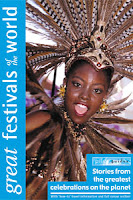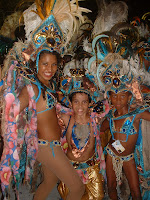 The schools are judged in 10 categories. There are 4 judges of every category (altogether 40 of them). Every judge gives his scores on a scale of 5-10 (with fractions), 10 being the best one. They are counted and announced on Ash Wednesday, just after Carnival. The judges' booths are spread along the Samba Avenue (most of them in Sector 2, opposite Sector 7) and are clearly marked with a banner reading "Julgadores".
The schools are judged in 10 categories. There are 4 judges of every category (altogether 40 of them). Every judge gives his scores on a scale of 5-10 (with fractions), 10 being the best one. They are counted and announced on Ash Wednesday, just after Carnival. The judges' booths are spread along the Samba Avenue (most of them in Sector 2, opposite Sector 7) and are clearly marked with a banner reading "Julgadores".The 10 categories in which the samba schools are judged
1. Percussion Band
2. Samba Song
3. Harmony
4. Flow and Spirit
5. Theme of the Year
6. Overall Impression
7. Floats and Props
8. Costumes
9. Vanguard Group
10. The Flag Bearer
Percussion Band
They should keep up the rhythm during the entire parade. All paraders should be singing and dancing in the rhythm set by the group. The 4 judges are looking for the regularity and continuity of the beat, a consistently firm and precise beat from the big surdo drums, an effective overall and well balanced sound of all the instruments. The rhythm should be varied and diverse but should be maintained perfectly, especially when the instruments restart after a break. They should maintain the same speed. The group's versatility is vital. It is forbidden to use wind or brass instruments.
Samba Song
It must contain the essence of the central theme which the School is presenting through their parade that year. The lyrics must fit the music and it is also judged by its artistic credentials. This is the only category where the judges subdivide their marks, giving some for the lyrics and some for the melody.
Harmony
The musical, acoustical and visual harmony of the School's parade. It requires perfect unity, continuity, melding and interchange in between the singing, rhythm, choreography and dance of the School's members. Marks can also be lost through feeble singing.
Flow and Spirit of the Participants
Harmony and progress of the participants' movements and dance with the rhythm of the music. The procession must keep a steady flow while being spontaneous and creative at the same time, expressing passion, agility and vigor of the participants. Penalty points are incurred if gaps open up between the paraders or the wings.
Theme of the Year
This is the central theme which the school had chosen, written and is representing through all parts of its entire parade. It is an artistic literary creation in the first place, in a written form. The judges consider, amongst other factors, the strength of the idea as a whole and the development of this idea through the various wings and floats. It should be possible to easily understand the theme and the central idea behind the show. The theme could also have some foreign reference. Penalty points are incurred however if any form of advertising is involved.
Overall Impression
This is judged freely without any technical criteria where the general impact of the school's parade is considered. It is the most subjective category and as such very controversial.
Floats and Props
This category judges the visual expression of the theme, the originality and quality of the artistic work such as the movements, colors and visual effects involved. The judges look at the floats and all props being used in the parade. The judges consider how effective the floats and props deliver the theme, how their design supports the theme's ideas. The costumes of the destaques (the most lavish costumes on top of the floats and elsewhere in the parade) are also judged in this category.
Costumes
The costumes' creativity, originality, an overall 'good taste' and their color schemes are evaluated in this category. Judges look at the individual costumes and their overall effect as a whole, at the same time. Diversity is also important just as much as the costumes' suitability to deliver the idea they stand for. Most costumes are considered in this category including all the commercial wings, the samba dancers, the percussionists and the Swirling Ladies.
Vanguard Commission
In this category are judged all aspects of the School's opening wing. Judges consider their choreography and costumes and how their show serves their main purpose of introducing the School to the the public.
The Flag Bearer and her Escort
The first dancing master and his partner, the flag carrier lady, are considered in this category. The judges look at their dance, elegance, grace and agility; at the flexibility and variety of their movements, and judge the symbolic protection of the Flag. Coordination in between the two as a couple is also important.














